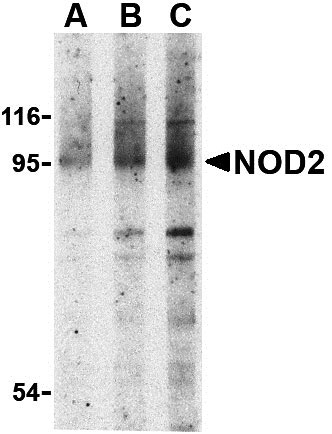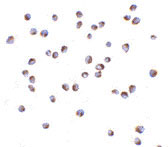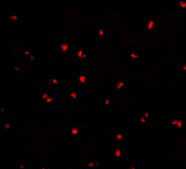NOD2 Antibody
- 产品详情
- 实验流程
- 背景知识
Application
| WB, IF, E, IHC-P |
|---|---|
| Primary Accession | Q9HC29 |
| Other Accession | Q9HC29, 20137973 |
| Reactivity | Human |
| Host | Rabbit |
| Clonality | Polyclonal |
| Isotype | IgG |
| Calculated MW | 115283 Da |
| Concentration (mg/ml) | 1 mg/mL |
| Conjugate | Unconjugated |
| Application Notes | NOD2 antibody can be used for detection of NOD2 by Western blot at 1 to 4 µg/mL. Antibody can also be used for immunohistochemistry starting at 5 µg/mL. For immunofluorescence start at 10 µg/mL. |
| Gene ID | 64127 |
|---|---|
| Other Names | NOD2 Antibody: CD, ACUG, BLAU, IBD1, NLRC2, NOD2B, CARD15, CLR16.3, PSORAS1, Nucleotide-binding oligomerization domain-containing protein 2, Caspase recruitment domain-containing protein 15, nucleotide-binding oligomerization domain containing 2 |
| Target/Specificity | NOD2; At least four isoforms of NOD2 are known to exist; this antibody will only detect the longest isoform. NOD2 has no cross-reaction with NOD1. |
| Reconstitution & Storage | NOD2 antibody can be stored at 4℃ for three months and -20℃, stable for up to one year. As with all antibodies care should be taken to avoid repeated freeze thaw cycles. Antibodies should not be exposed to prolonged high temperatures. |
| Precautions | NOD2 Antibody is for research use only and not for use in diagnostic or therapeutic procedures. |
| Name | NOD2 {ECO:0000303|PubMed:11087742, ECO:0000312|HGNC:HGNC:5331} |
|---|---|
| Function | Pattern recognition receptor (PRR) that detects bacterial peptidoglycan fragments and other danger signals and plays an important role in gastrointestinal immunity (PubMed:12514169, PubMed:12527755, PubMed:12626759, PubMed:15044951, PubMed:15998797, PubMed:27283905, PubMed:27748583, PubMed:31649195). Specifically activated by muramyl dipeptide (MDP), a fragment of bacterial peptidoglycan found in every bacterial peptidoglycan type (PubMed:12514169, PubMed:12527755, PubMed:12626759, PubMed:12871942, PubMed:15044951, PubMed:15198989, PubMed:15998797, PubMed:22857257, PubMed:23322906, PubMed:27748583, PubMed:36002575). NOD2 specifically recognizes and binds 6-O-phospho- MDP, the phosphorylated form of MDP, which is generated by NAGK (PubMed:36002575). 6-O-phospho-MDP-binding triggers oligomerization that facilitates the binding and subsequent activation of the proximal adapter receptor-interacting RIPK2 (PubMed:11087742, PubMed:17355968, PubMed:21887730, PubMed:23806334, PubMed:28436939). Following recruitment, RIPK2 undergoes 'Met-1'- (linear) and 'Lys-63'-linked polyubiquitination by E3 ubiquitin-protein ligases XIAP, BIRC2, BIRC3 and the LUBAC complex, becoming a scaffolding protein for downstream effectors, triggering activation of the NF-kappa-B and MAP kinases signaling (PubMed:11087742, PubMed:12514169, PubMed:12626759, PubMed:15198989, PubMed:21887730, PubMed:23322906, PubMed:23806334, PubMed:28436939). This in turn leads to the transcriptional activation of hundreds of genes involved in immune response (PubMed:15198989). Its ability to detect bacterial MDP plays a central role in maintaining the equilibrium between intestinal microbiota and host immune responses to control inflammation (By similarity). An imbalance in this relationship results in dysbiosis, whereby pathogenic bacteria prevail on commensals, causing damage in the intestinal epithelial barrier as well as allowing bacterial invasion and inflammation (By similarity). Acts as a regulator of appetite by sensing MDP in a subset of brain neurons: microbiota-derived MDP reach the brain, where they bind and activate NOD2 in inhibitory hypothalamic neurons, decreasing neuronal activity, thereby regulating satiety and body temperature (By similarity). NOD2- dependent MDP-sensing of bacterial cell walls in the intestinal epithelial compartment contributes to sustained postnatal growth upon undernutrition (By similarity). Also plays a role in antiviral response by acting as a sensor of single-stranded RNA (ssRNA) from viruses: upon ssRNA-binding, interacts with MAVS, leading to activation of interferon regulatory factor-3/IRF3 and expression of type I interferon (PubMed:19701189). Also acts as a regulator of autophagy in dendritic cells via its interaction with ATG16L1, possibly by recruiting ATG16L1 at the site of bacterial entry (PubMed:20637199). NOD2 activation in the small intestine crypt also contributes to intestinal stem cells survival and function: acts by promoting mitophagy via its association with ATG16L1 (By similarity). In addition to its main role in innate immunity, also regulates the adaptive immune system by acting as regulator of helper T-cell and regulatory T-cells (Tregs) (By similarity). Besides recognizing pathogens, also involved in the endoplasmic reticulum stress response: acts by sensing and binding to the cytosolic metabolite sphingosine-1-phosphate generated in response to endoplasmic reticulum stress, initiating an inflammation process that leads to activation of the NF-kappa-B and MAP kinases signaling (PubMed:27007849, PubMed:33942347). May also be involved in NLRP1 activation following activation by MDP, leading to CASP1 activation and IL1B release in macrophages (PubMed:18511561). |
| Cellular Location | Cell membrane; Lipid-anchor. Basolateral cell membrane. Cytoplasm Mitochondrion. Note=Palmitoylation promotes localization to the cell membrane, where it detects bacterial invasion at the point of entry. |
| Tissue Location | Expressed in monocytes, macrophages, dendritic cells, hepatocytes, preadipocytes, epithelial cells of oral cavity, lung and intestine, with higher expression in ileal Paneth cells and in intestinal stem cells. |
For Research Use Only. Not For Use In Diagnostic Procedures.
Provided below are standard protocols that you may find useful for product applications.
BACKGROUND
NOD2 Antibody: Apaf-1 and NOD1 are members of a new family, which are involved in the regulation of apoptosis and immune response. Each of them contains a caspase recruitment domain (CARD) and a nucleotide-binding oligomerization domain (NOD). A third member in this family was recently identified and designated NOD2. NOD2 interacts with RICK via a homophilic CARD-CARD interaction. NOD2 activates NF-κB, which is regulated by its carboxy-terminal leucine-rich repeat domain that acts as an intracellular receptor for components of bacteria. The variants of NOD2, either a frameshift or a missense, were associated with Crohn's disease that is a main type of chronic inflammatory bowel disease.
REFERENCES
Inohara N, Koseki T, del Peso L, et al. Nod1, an Apaf-1-like activator of caspase-9 and nuclear factor-κB. J. Biol. Chem. 1999; 274:14560-7.
Ogura Y, Inohara N, Benito A, et al. Nod2, a Nod1/Apaf-1 family member that is restricted to monocytes and activates NF-κB. J. Biol. Chem. 2001; 276:4812-8.
Hugot JP, Chamaillard M, et al. Association of NOD2 leucine-rich repeat variants with susceptibility to Crohn's disease. Nature 2001; 411:599-603.
Ogura Y, Bonen DK, Inohara N, et al. A frameshift mutation in NOD2 associated with susceptibility to Crohn's disease. Nature 2001; 411:603-6.
终于等到您。ABCEPTA(百远生物)抗体产品。
点击下方“我要评价 ”按钮提交您的反馈信息,您的反馈和评价是我们最宝贵的财富之一,
我们将在1-3个工作日内处理您的反馈信息。
如有疑问,联系:0512-88856768 tech-china@abcepta.com.























 癌症的基本特征包括细胞增殖、血管生成、迁移、凋亡逃避机制和细胞永生等。找到癌症发生过程中这些通路的关键标记物和对应的抗体用于检测至关重要。
癌症的基本特征包括细胞增殖、血管生成、迁移、凋亡逃避机制和细胞永生等。找到癌症发生过程中这些通路的关键标记物和对应的抗体用于检测至关重要。 为您推荐一个泛素化位点预测神器——泛素化分析工具,可以为您的蛋白的泛素化位点作出预测和评分。
为您推荐一个泛素化位点预测神器——泛素化分析工具,可以为您的蛋白的泛素化位点作出预测和评分。 细胞自噬受体图形绘图工具为你的蛋白的细胞受体结合位点作出预测和评分,识别结合到自噬通路中的蛋白是非常重要的,便于让我们理解自噬在正常生理、病理过程中的作用,如发育、细胞分化、神经退化性疾病、压力条件下、感染和癌症。
细胞自噬受体图形绘图工具为你的蛋白的细胞受体结合位点作出预测和评分,识别结合到自噬通路中的蛋白是非常重要的,便于让我们理解自噬在正常生理、病理过程中的作用,如发育、细胞分化、神经退化性疾病、压力条件下、感染和癌症。








